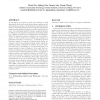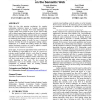9 search results - page 1 / 2 » Subspace similarity search using the ideas of ranking and to... |
ICDE
2010
IEEE
13 years 5 months ago
2010
IEEE
— There are abundant scenarios for applications of similarity search in databases where the similarity of objects is defined for a subset of attributes, i.e., in a subspace, onl...
SIGIR
2012
ACM
11 years 7 months ago
2012
ACM
In this paper, we propose a novel top-k learning to rank framework, which involves labeling strategy, ranking model and evaluation measure. The motivation comes from the difficul...
SAC
2006
ACM
13 years 11 months ago
2006
ACM
Traditional semantic web query languages support a logicbased access to the semantic web. They offer a retrieval (or reasoning) of data based on facts. On the traditional web and...
WWW
2005
ACM
14 years 6 months ago
2005
ACM
While the idea that querying mechanisms for complex relationships (otherwise known as Semantic Associations) should be integral to Semantic Web search technologies has recently ga...
CORR
2008
Springer
13 years 5 months ago
2008
Springer
The LETOR website contains three information retrieval datasets used as a benchmark for testing machine learning ideas for ranking. Algorithms participating in the challenge are re...


